Smartphones enabled up to 58 s strong-shaking warning in the M7.8 Türkiye earthquake – Scientific Reports
Public earthquake early warning systems (PEEWSs) combine seismic monitoring technologies and communication infrastructures to alert people of an imminent earthquake. PEEWSs are operational in only a few countries that are located in seismic zones1; their widespread use is limited by large implementation costs2 and legislative issues3. Smartphone-based PEEWSs are low-cost and crowdsourced4 alternatives to classic systems. The Earthquake Network (EQN)5 and the Android Earthquake Alerts System by Google6 are the two public smartphone-based PEEWSs operational at the global level. EQN became operational in 2013, with earthquake detection data routinely collected and stored from 2017 onwards7. Google’s system was initially deployed only in certain countries from 2021 onwards8.
The EQN alerting service is an opt-in one. Citizens must install the EQN app on their smartphones (Android, iOS or Huawei) to join the seismic monitoring and to receive alerts. When the smartphone is charging, the app enables seismic monitoring and data transfer to the EQN server infrastructure. During monitoring, the app analyses the smartphone’s acceleration in real time to detect significant shaking relative to the sensor’s background noise. Once a shaking starts, the app calculates the peak resultant acceleration over a 3-s window, hereafter called the smartphone peak resultant acceleration, and sends this information to the EQN server along with the smartphone coordinates. No waveforms are transmitted to the server. Monitoring by the app ends when the shaking is no longer distinguishable from sensor noise or when someone interacts with the smartphone.
When an earthquake is detected by the EQN system, smartphone peak resultant accelerations sent to the server are analysed to estimate the EQN median acceleration, infer the magnitude of the detected earthquake from this median acceleration and determine warning distances for mild, moderate, and strong shaking. EQN app users then receive an alert with a personalised countdown (with respect to the theoretical arrival of the S-wave) and expected ground-shaking intensity based on their location.
The EQN performance has been studied in terms of earthquake detectability9, alerting performance7 and user appreciation10. However, the effectiveness of smartphone-based PEEWSs has never been assessed during a large-magnitude (M > 7.5) destructive event in an inhabited area.
The magnitude 7.8 Pazarcik earthquake of 6 February 2023 was the fifth deadliest event in the last 20 years11,12. Türkiye does not have a national PEEWS but is covered by both the EQN and the Google systems. According to an investigation by the BBC ( the Google system failed to alert people. In contrast, the EQN system detected the earthquake and issued an alert to its users and on social networks (https://twitter.com/SismoDetector/status/1622404158618730498). The Pazarcik earthquake is the second largest destructive event—after the M 9.0 earthquake in Tohoku (Japan) in 2011—in terms of magnitude for which a public early warning was issued13 and also the first such onshore earthquake of this magnitude detected by a smartphone-based PEEWS for which data are available.
Large-magnitude earthquakes are challenging because of their long rupture length and duration. The rupture of the Pazarcik earthquake occurred over a fault length of 350 km and the total rupture duration was close to 80 s14,15. Most PEEWSs work by estimating shaking levels from rapidly determined earthquake parameters and issuing an alert to potentially affected people. Their performance is limited by how quickly the earthquake parameters and the uncertainty associated with the shaking level can be estimated, particularly for high intensity ground motions16,17,18. The EQN alerting strategy is similar to the onsite approach19, as it estimates alerting distances for different shaking levels from the first few seconds of the seismic waves without waiting for the end of the rupture.
This paper analyses and discusses the EQN alerting strategy and its warning performance during the Pazarcik earthquake. First, we present a detailed description of the operation of the EQN system during this major event (number of users at the time of the earthquake, number and location of detections, and information and timing of information sent to users). Second, the waveforms collected by the accelerometric stations of the Disaster and Emergency Management Authority (AFAD) of Türkiye are used to estimate the actual warning times offered by EQN to its Turkish and Syrian users with respect to a given ground shaking level. Third, we evaluate the number of Turkish and Syrian people who could have benefitted from these warning times if the alert had been issued to the entire population within the area where strong shaking was expected.
Deployment and use of EQN before the Pazarcik earthquake
Before the Pazarcik earthquake, the EQN app had been downloaded more than 12 million times worldwide, and the number of active users is about 1 million worldwide and 33,000 in Türkiye. The EQN system has already issued 60 alerts worldwide for earthquakes of magnitude 5.5 and above. None of these earthquakes had an epicentre in Türkiye. However, EQN users located to the southwest of Türkiye received alerts for offshore earthquakes in Crete (Greece). These included a 5.7 magnitude earthquake on 29 December 2021 and a 5.5 magnitude earthquake on 20 November 2022.
Pazarcik earthquake detection by the EQN
At the time of the Pazarcik event, 53 smartphones located within 100 km of the epicentre were monitoring for earthquakes. The EQN detection occurred at 01:17:46 UTC on 6 February 2023 with a delay of 12.1 s with respect to the origin time t0 given by U.S. Geological Survey (USGS). This was the time it took for the seismic waves to reach enough monitoring smartphones and for the EQN detection algorithm to recognise the ongoing earthquake.
The detection and assessment of the level of shaking was based on 20 of the 53 smartphones, mainly located in the cities of Gaziantep and Kahramanmaraş, approximately 37 km and 39 km from the epicentre. The EQN estimated epicentre (37.481° latitude, 36.997° longitude) had an error of 16.7 km with respect to the epicentre provided by the USGS.
Figure 1 details the smartphone network configuration at the time of the EQN detection. The figure highlights the smartphones that detected the earthquake (triggering smartphones), the smartphones that were monitoring at the time of the EQN detection (but not yet triggered) and the smartphones with the EQN app installed (but not charging and thus not monitoring). The estimated locations of the P- and S-waves at the time of EQN detection reveal that the smartphones triggered on the P-wave.
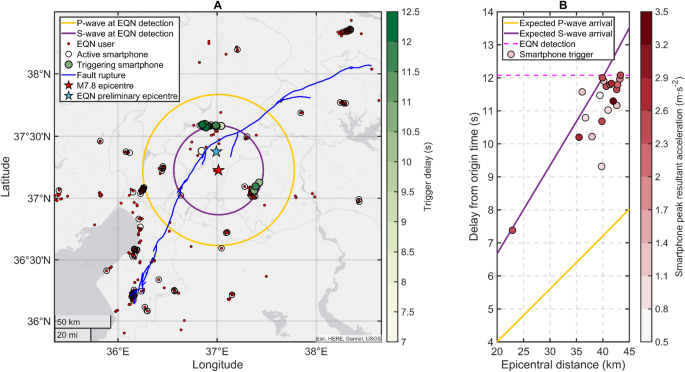
Relevant information regarding the EQN detection of the M7.8 Pazarcik earthquake on 6 February 2023. (A) State of the EQN smartphone network at the time of the earthquake detection, including: smartphones that detected the earthquake (filled circles), active monitoring smartphones (transparent circles) and smartphones with the EQN app installed but not monitoring (red circles). Map generated by authors using the MATLAB R2023a software. (B) Smartphone triggering delay (s) from origin time versus epicentral distance (km).
Alerting strategy
The alert was distributed to EQN users located within circular areas centred on the estimated epicentre, with a radius determined from the intensity predictive equation described in the Methods section. At t0 + 12.78 s and after 0.68 s of the EQN detection time—a delay necessary to assess the shaking level and to identify the EQN users requiring an alert—the EQN issued the alert with a warning for strong ground shaking to 382 EQN users (active or not) within a radius of 141 km, with a warning for moderate shaking to 738 users within a radius of 141–412 km (in Türkiye but also Syria, Cyprus and Lebanon), and with a warning for mild shaking to 62,419 users (in Türkiye and many other countries) within a radius of 412–3506 km. The ability to transcend boundaries is a key feature that differentiates EQN from national warning systems.
Warning time analysis
The effectiveness of the EQN alerting service is assessed by calculating the spatial distribution of the warning time and the warning time given to smartphone users with the EQN app installed at the time of the magnitude 7.8 event.
We evaluate the warning time as the time difference between the EQN alert (given at t0 + 12.78 s) and when the peak ground acceleration (PGA) measured on accelerometric stations exceeds 12%g, with g being the Earth’s acceleration of gravity. The 12%g PGA threshold corresponds to the modified Mercalli intensity of VI20. Thus, the warning time is calculated for a level of ground shaking at which people can still take protective measures.
Waveforms collected by the stations of the Turkish Disaster and Emergency Management Authority (AFAD) were initially analysed to determine the geographical region where the PGA surpassed 12%g. Within this area, the warning time was estimated at the AFAD stations and interpolated over space using statistical modelling (see “Methods” section).
Figure 2 reveals that the warning time extended up to 66 s within the 12%g exceedance region and up to 58 s within the 141 km radius of strong ground-shaking warning. Table 1 details the minimum and maximum warning times for some ranges of epicentral distance. Due to the anisotropy of the warning time, its variability in each range is relatively high.
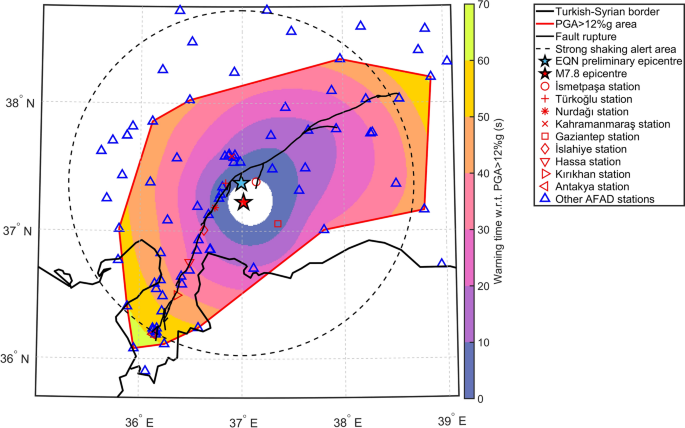
Spatial distribution of the warning time (s), with respect to the exceedance of the 12%g PGA threshold, provided by the EQN system during the M7.8 Pazarcik earthquake. Map generated by authors using the MATLAB R2023a software.
Figure 3 illustrates, for a few selected AFAD stations located in major cities and towns, the waveform plots of the east–west component (the largest component due to the effects of fault-normal directivity) recorded by the station accelerometer. A few cities and towns that experienced high levels of ground shaking benefitted from relatively long warning times. This is a consequence of the rapid EQN detection and the length of the fault rupture. The AFAD station in Antakya, 146 km from the epicentre (see Fig. 2), recorded a PGA of 138%g and the macroseismic intensity within the city reached an intensity of XI on the modified Mercalli scale (see Fig. 4). EQN users living in Antakya received an alert approximately 60 s before the 12%g PGA was exceeded, but the warning was for moderate ground shaking rather than strong ground shaking. This is because the city is approximately 160 km from the epicentre estimated by the EQN, thereby exceeding the 141 km radius of the strong-shaking warning. Table 2 shows how many EQN users received a warning for moderate shaking even though they were exposed to strong shaking (i.e. macroseismic intensity equal to or greater than VI). However, the warning time for users outside the 141 km radius was more than 40 s (see Fig. 2). This means that, despite the underestimated shaking level, all users had enough time to respond to the alert.
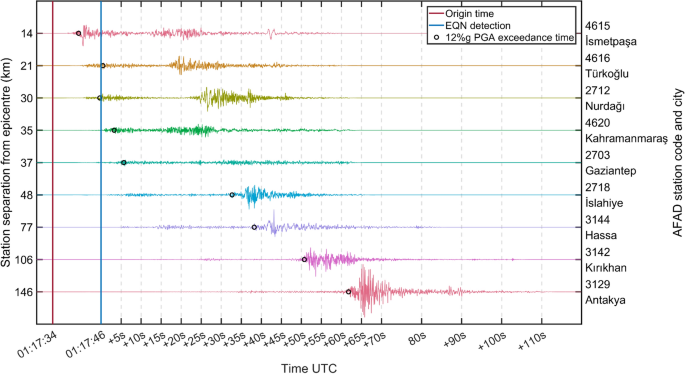
Waveforms of the east–west component recorded by AFAD stations located in major cities and towns affected by the M7.8 earthquake of 6 February 2023. The warning time at the station is the difference between the EQN alert time and the time when PGA exceeded 12%g.
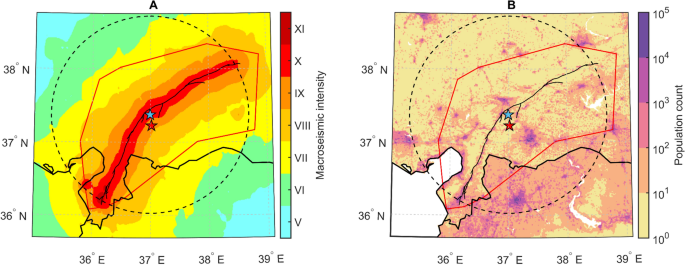
(A) Spatial distribution of macroseismic intensity23. (B) Spatial distribution of the population. The Fault rupture is taken from Reitman et al. (2023), while macroseismic intensity is taken from Hancilar et al.23. Legend in Fig. 2. Maps generated by authors using the MATLAB R2023a software.
The estimated fatality rate in Türkiye is 1/38 for people exposed to macroseismic intensity IX and above, and 1/1000 for people exposed to intensity VIII21. It is interesting to estimate the actual warning time distribution for the EQN users located within the 141 km radius who received a strong ground-shaking warning. Figure 5 depicts that 230 users were exposed to macroseismic intensity of IX and above, while 124 users were exposed to intensity VIII. The maximum warning time was 58 and approximately 53 s, respectively.
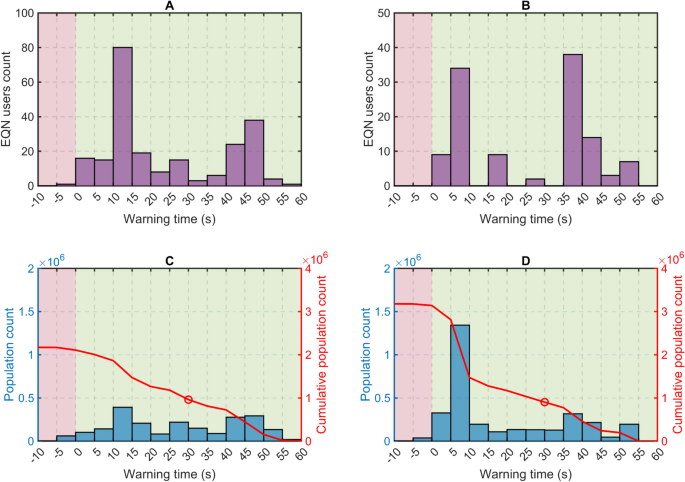
(A) Warning time distribution for EQN users exposed to intensity IX, X and XI and (B) exposed to intensity VIII. (C) Potential warning time distribution for the Turkish–Syrian population exposed to intensity IX, X and XI and (D) exposed to intensity VIII if the strong ground-shaking alert were provided to the entire population. The warning time is based on exceeding the 12%g peak ground acceleration threshold and is calculated for the EQN users and for the population located within the 141 km radius centred on the EQN preliminary epicentre. The red graph displays the number of people who could potentially have benefitted from an increased warning time than any given value. The circles in (C) and (D) represent the number of people who could potentially have benefitted from a warning time exceeding 30 s.
Potential warning time distribution among the Turkish-Syrian population
The warning time analysis conducted with EQN users was also applied to the Turkish–Syrian population to evaluate the potential warning time for those exposed to intensities of VIII or higher. This was done under the assumption that the distribution of the strong-shaking warning would have encompassed the entire population located within the 141 km radius (Fig. 4). While this assumption of a larger number of potential users implies a significant but manageable change in the EQN alert mechanism (see “Discussion” in the next section), it is nevertheless useful to assess the potential of the EQN as a PEEWS open to all citizens22.
Figure 5 indicates that approximately 2.2 million people within the radius were exposed to macroseismic intensities of IX and above and 3.2 million people to intensity VIII. A warning time of between 30 and 58 s would have been given to 960,000 and 902,000 people, respectively. On the other hand, 826,000 people exposed to intensities of VIII or higher would have received a moderate-shaking warning (thus with the intensity underestimated) with a warning time of between 38 and 66 s.
Could EQN have warned millions of people?
A critical aspect of EQN is the ability to alert potentially millions of users. EQN relies on the Firebase Cloud Messaging (FCM) solution24, which enables back-end server infrastructures to send notifications and alerts to smartphone apps. The current EQN alerting rate is approximately 100,000 users per second, and the alert is distributed by ordering the users with respect to their distance to the preliminary epicentre. This rate allows EQN to provide a reliable EEW service to its users, which are currently around 2 million distributed worldwide. If EQN needed to alert millions of users in a relatively small area, the current alerting rate would not be high enough (if compared to the speed of seismic wave propagation) and EQN would have to switch to a different alerting method which is also made available by the FCM. This other method, which is likely the same one used by Google’s Android Earthquake Alerts System to alert its large user base, allows to alert million of smartphones but it does not allow to control the order in which the alert is distributed and, according to the technical documentation, may have a higher latency.
Another relevant aspect is the ability for the EQN to serve the users who install and interact with the app after a felt earthquake. The EQN server infrastructure is designed to serve a certain maximum number of app users. This exposes EQN to potential service degradation (including the real-time monitoring) if the number of users increases rapidly following a widely felt earthquake. For example, after the M7.8 event, the number of Turkish users increased from 33,000 to 225,000 within a few hours and the saturation of the EQN infrastructure prevented the detection of the M7.5 Elbistan earthquake which occurred 9 h after the Pazarcik earthquake. The problem was resolved within two days by adding more servers to the infrastructure. This type of problem can be avoided by using autoscaling solutions in the cloud, but these are usually more expensive. The EQN citizen science initiative is entirely funded by citizens who voluntarily purchase the PRO version of the app or its priority services. These services allow them to be among the first 100,000 users to receive the alert, regardless of their distance from the epicentre. While this alerting scheme may slightly alter the order in which the alert is distributed, it does not prevent non-purchasing users from receiving the alert.


/cloudfront-us-east-2.images.arcpublishing.com/reuters/7Q2EXSMVRZPB3BXKQV4AEQAQS4.jpg)
